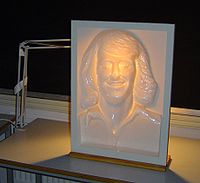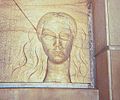- Hollow-Face illusion
-
 This face of Björn Borg appears convex (pushed out), but is actually concave (pushed in).
This face of Björn Borg appears convex (pushed out), but is actually concave (pushed in).
The Hollow-Face illusion (also known as Hollow-Mask illusion) is an optical illusion in which the perception of a concave mask of a face appears as a normal convex face.
While a convex face will appear to look in a single direction, and a flat face such as the Lord Kitchener Wants You poster can appear to follow the moving viewer, a hollow face can appear to move its eyes faster than the viewer: looking forward when the viewer is directly ahead, but looking at an extreme angle when the viewer is only at a moderate angle.
Says Richard Gregory, "The strong visual bias of favouring seeing a hollow mask as a normal convex face (figure 1), is evidence for the power of top-down knowledge for vision" (Gregory 1970). This bias of seeing faces as convex is so strong it counters competing monocular depth cues, such as shading and shadows, and also very considerable unambiguous information from the two eyes signalling stereoscopically that the object is hollow. (Lighting a concave face from below to reverse the shading cues making them closer to those of a convex face lit from above can reinforce the illusion.)
Another example of the Hollow-Face illusion is the "Gathering For Gardner" dragon. This dragon's head seems to follow the viewer's eyes everywhere (even up or down), when lighting, perspective and/or stereoscopic cues are not strong enough to tell its face is actually hollow. Keen observers will note that the head doesn't actually follow them, but appears to turn twice as fast around its center than they do themselves.[citation needed]
Contents
Further examples
-
An optical illusion. The paper dragon from Grand Illusions, shown from four angles across the 90 degree effective viewing area
Video view of the Gathering for Gardner dragon paper model
References
- "Knowledge in perception and illusion" by Richard Gregory, Phil. Trans. R. Soc. Lond. B (1997) 352, 1121–1128 - authoritative introduction to optical illusions.
See also
External links
Categories:- Optical illusions
-
Wikimedia Foundation. 2010.


